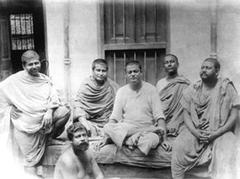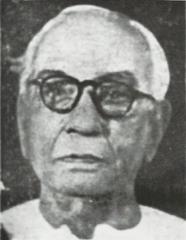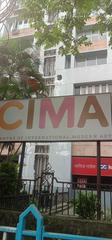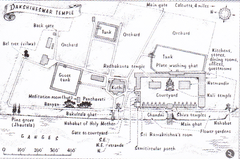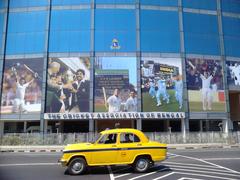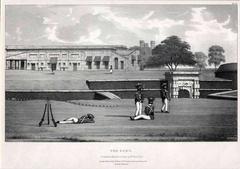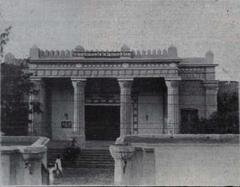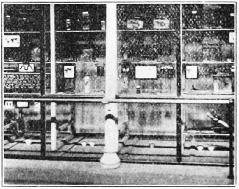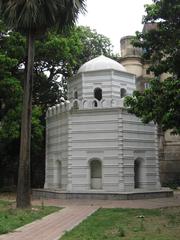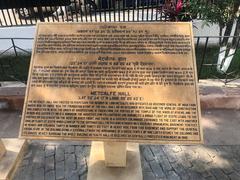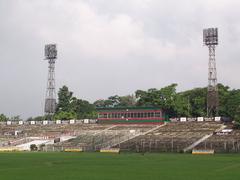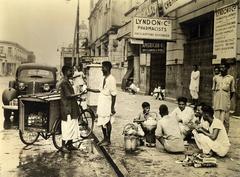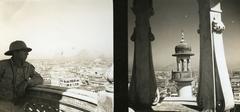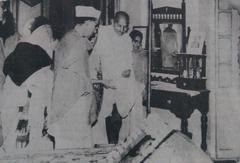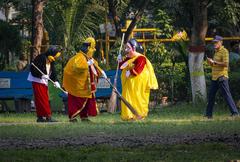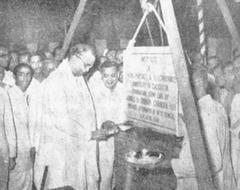Zakaria Street Kolkata: Visiting Hours, Tickets, and Historical Sites Guide
Date: 03/07/2025
Introduction
Zakaria Street, situated in the heart of Central Kolkata near the historic Chitpur neighborhood, is a vibrant symbol of the city’s multicultural spirit. Blending deep historical roots, architectural marvels, religious significance, and a legendary food scene—particularly during Ramadan—this bustling street is a microcosm of Kolkata’s pluralistic ethos. From the imposing Nakhoda Masjid to the aromatic food stalls that spring to life after sunset, Zakaria Street offers an immersive experience for history enthusiasts, food lovers, and cultural explorers alike. This comprehensive guide covers its origins, cultural importance, practical visitor information, nearby attractions, and insider tips to help you make the most of your visit (GetBengal; The Telegraph India; Orangewayfarer; Good Food Bro).
Table of Contents
- Historical Roots and Evolution
- Architectural and Religious Landmarks
- Culinary Heritage and Food Experiences
- Social Fabric and Community Life
- Visiting Zakaria Street: Practical Information
- Must-See Spots and Attractions
- Markets, Bazaars, and Specialty Shops
- Nearby Attractions
- Travel Tips and Visitor Etiquette
- FAQs
- Visuals and Media
- Internal and Related Links
- Conclusion
Historical Roots and Evolution
Zakaria Street, originally known as Jacquaria Street, developed in the late 19th and early 20th centuries as a dynamic hub for Kolkata’s Muslim community (The Telegraph India). Named after a prominent local merchant, the street flourished as a center for trade, migration, and religious activity. Its heritage buildings, mosques, and trading houses speak to a rich colonial and post-colonial legacy.
Architectural and Religious Landmarks
Nakhoda Masjid
The street’s crowning glory is the Nakhoda Masjid, constructed in 1926 and inspired by Mughal architecture. With its red sandstone façade, grand domes, and ornate arches, it anchors the neighborhood both spiritually and architecturally. The mosque is particularly vibrant during Ramadan and Eid, drawing crowds from across the city (GetBengal; Nakhoda Masjid Official).
Cultural and Spiritual Diversity
Beyond the mosque, Zakaria Street features smaller shrines, madrasas, and Sufi dargahs, fostering an atmosphere of religious pluralism and communal harmony (Times of India).
Culinary Heritage and Food Experiences
Zakaria Street’s legendary food culture is a highlight for visitors, especially during Ramadan. After sunset, the street transforms into a bustling open-air food market, offering Mughlai, Awadhi, and Bengali Muslim delicacies (NDTV Food). Must-try dishes include:
- Kebabs: Seekh, Suta, Sutli, and Shami kebabs (try Adam’s Kabab Shop)
- Biryani: Fragrant, Kolkata-style biryani with tender meat and potato (Royal India Hotel)
- Haleem/Daleem: Slow-cooked stew, lighter and soupier in the local style (Sufia)
- Chicken Changezi and Afghani Chicken: Rich Mughlai gravies (Taskeen, Dilli 6)
- Sheermal & Bakarkhani: Saffron-infused flatbreads and spiced loaves
- Sweets: Phirni, jalebi, sevai kheer, gulab jamun (Haji Allauddin Sweets)
During Ramadan, communal iftar meals and food walks attract thousands, celebrating the area’s culinary inclusivity (The Hindu).
Social Fabric and Community Life
Zakaria Street’s residents reflect Kolkata’s diversity, with Bengalis, Marwaris, Biharis, and North Indians coexisting amid a tapestry of markets, traditional shops, and modern boutiques (Outlook India). Local clubs and cultural associations organize mehfils, poetry gatherings, and festivals, preserving a rich intangible heritage (India Today).
Visiting Zakaria Street: Practical Information
- Visiting Hours: Open year-round. Food stalls operate from late afternoon to midnight; peak activity during Ramadan evenings (7 PM–11 PM).
- Entry Fee: None. Nakhoda Masjid also welcomes visitors free of charge.
- Accessibility: The area features narrow, crowded lanes; comfortable footwear is recommended. Wheelchair access is limited.
- How to Get There: Closest metro stations are Girish Park, Esplanade, and Mahatma Gandhi Road. Buses, taxis, and auto-rickshaws are readily available.
- Nearby Attractions: Burrabazar market, Indian Museum, Howrah Bridge, Chitpur neighborhood.
- Travel Tips: Dress modestly, especially during Ramadan; carry cash; respect prayer times and religious customs.
Must-See Spots and Attractions
Nakhoda Masjid
The largest mosque in East India, famed for its Mughal-inspired grandeur and welcoming atmosphere (Orangewayfarer).
Historic Eateries
- Adam’s Kabab Shop: Iconic Suta and Boti Kababs
- Royal India Hotel: Kolkata biryani and mutton chaap
- Dilli 6, Taskeen, Sufia, Haji Allauddin Sweets
Salim Manzil and Presidency Muslim High School
Heritage sites reflecting the area’s architectural and educational legacy (Maktoob Media).
Markets, Bazaars, and Specialty Shops
- Ramadan Market: Kolkata’s largest, selling food, attar, dry fruits, and festive clothing (Wikipedia).
- Year-Round Bazaars: Spices, textiles, zari, and household goods, with Barabazar nearby (Orangewayfarer).
Nearby Attractions
- Mohammad Ali Park: Tranquil green space for relaxation.
- Tirretti Bazar: Early morning Chinese breakfasts, highlighting Kolkata’s multiculturalism (Orangewayfarer).
Travel Tips and Visitor Etiquette
- Best Time to Visit: Evenings during Ramadan for the liveliest experience; winter offers a quieter yet charming atmosphere.
- Dress & Behavior: Modest attire is a must. Avoid public eating/drinking before iftar during Ramadan. Seek permission before photographing locals or religious sites (Kolkata Tourism).
- Health & Safety: Carry bottled water, use hand sanitizer, and be mindful of crowds. The area is generally safe, but watch your belongings (Travel Like a Boss).
Frequently Asked Questions (FAQ)
Q: What are Zakaria Street’s visiting hours?
A: The street is open all day. Food stalls are busiest from late afternoon into the night, especially during Ramadan.
Q: Is there an entry fee or ticket required?
A: No, access to Zakaria Street and Nakhoda Masjid is free.
Q: Are non-Muslims welcome at the mosque?
A: Yes, outside prayer times and with respect for local customs.
Q: How accessible is Zakaria Street?
A: The street is crowded and narrow; wheelchair users may need assistance.
Q: Are guided tours available?
A: Yes, especially during Ramadan, with food walks and heritage tours offered by local operators (Kitchen of Debjani).
Visuals and Media
- High-quality images of Nakhoda Masjid, food stalls, and bustling street scenes are recommended with SEO-friendly alt text (e.g., “Zakaria Street Kolkata Ramadan food walk,” “Nakhoda Masjid Kolkata”).
- Consider embedding an interactive map marking key attractions and transport links.
Internal and Related Links
Conclusion
Zakaria Street stands as a living testament to Kolkata’s rich historical, spiritual, and culinary legacy. Anchored by the grand Nakhoda Masjid and brought to life by generations of traders, artisans, and food vendors, it exemplifies Kolkata’s pluralistic spirit. Whether you visit for its stunning architecture, to sample mouthwatering Mughlai and Awadhi delicacies, or to experience the vibrant Ramadan evenings, Zakaria Street promises an unforgettable journey through the soul of the city.
Plan your visit, explore guided tours for deeper insights, and immerse yourself in the flavors and stories that make Zakaria Street a true Kolkata icon. For up-to-date information, download the Audiala app and follow us on social media for tips, maps, and exclusive offers.
Sources
- GetBengal
- The Telegraph India
- Orangewayfarer
- Good Food Bro
- Times of India
- Travel + Leisure Asia
- NDTV Food
- The Hindu
- Outlook India
- India Today
- Kolkata Tourism
- Maktoob Media
- Wikipedia
- Homegrown
- Time2Digital
- Kitchen of Debjani
- Travel Like a Boss
- Agoda
